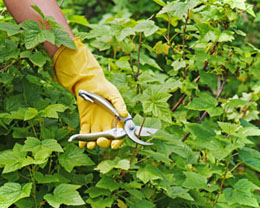Propagating plants from cuttings is an easy method to produce new plants within a short time. Under this asexual propagation method, cuttings are usually made from the shoot (stem), but they can also be taken from the leaves and roots.

For a gardening enthusiast, what can be more interesting than propagating numerous plants from a single parent plant. We all are accustomed with growing new plants from seeds. No doubt, seeds are one of the most versatile means for producing new plants. However, the major drawback of seed propagation is that some species of plants either do not produce seeds or majority of the seeds are not viable. In such cases, cuttings can be the ideal choice to produce new saplings.
In this asexual mode of reproduction, new plants are produced from an established plant by cutting, not by fertilization of the male and female gametes. Certain parts of the plant can be used for cutting purpose, which are mentioned below.
Stem Cuttings
Stem cuttings can be taken from the main stem or the side branches of the plant. Different types of stem cuttings are:
- Herbaceous Cutting―Houseplants like chrysanthemum, rhododendron, and geranium are propagated by herbaceous cutting. For this type, rooting is easy and the growth phase has nothing to do with root formation. So, you can make stem cuttings at any time, when the plant is growing actively.
- Softwood Cutting―This cutting is made from the new stem growth of the current season, and is easy to promote rooting. Deciduous shrubs like lilac, plum, rose, and forsythia are propagated by softwood cuttings.
- Semi-Hardwood Cutting―Broad-leaved evergreens like azalea, camellia, olive, citrus, and holly are propagated by semi-hardwood cutting. This method refers to cutting made from the stem growth of the current season, when the stem is not completely mature or hard.
- Hardwood Cutting―Over here, the hard stem of the previous year is used for propagation. Hardwood cutting is taken at a specific time of the year, particularly during winter when the plant is inactive or dormant. Deciduous and narrow-leaved evergreens like privet, honeysuckle, quince, grape, cypress, etc., are propagated by the hardwood cutting method.
Leaf Cuttings
Leaf cuttings can be made anytime from the plant. A healthy and disease-free leaf is cut smoothly from the plant, which is then used for generating a new plant. Unlike stem cuttings, that require only rooting, both shoot development and root formation are necessary in case of leaf cuttings. Not all plants can be propagated by means of leaf cutting. Plants like houseleek, rex begonia, and sansevieria are a few plants that can use this method successfully.
Root Cuttings
Propagation by root cuttings is also limited to a few species of herbaceous plants, shrubs and bushes, and trees. Examples of plants that can be propagated by this method include raspberry, blueberry, globe thistle, and acanthus. First, healthy roots of a specific size (approximately the diameter of a pencil) are exposed and cut in sections of about 1½ to 3 inches in length. In order to avoid confusion while placing the root cutting in the growth medium, the first top cutting should be made flat and the bottom cutting should be diagonal.
The cuttings made by the above methods are placed in favorable plant growth media, so as to promote quick rooting, stem growth, and leaf development. Based on the type of cutting, you can use a specific growth medium. For example, it is essential to promote root development in stem cuttings. So, in such a case, you can opt for root growth medium. Having brief knowledge will guide you to successfully grow the cuttings in the soil.






 For a gardening enthusiast, what can be more interesting than propagating numerous plants from a single parent plant. We all are accustomed with growing new plants from seeds. No doubt, seeds are one of the most versatile means for producing new plants. However, the major drawback of seed propagation is that some species of plants either do not produce seeds or majority of the seeds are not viable. In such cases, cuttings can be the ideal choice to produce new saplings.
For a gardening enthusiast, what can be more interesting than propagating numerous plants from a single parent plant. We all are accustomed with growing new plants from seeds. No doubt, seeds are one of the most versatile means for producing new plants. However, the major drawback of seed propagation is that some species of plants either do not produce seeds or majority of the seeds are not viable. In such cases, cuttings can be the ideal choice to produce new saplings.